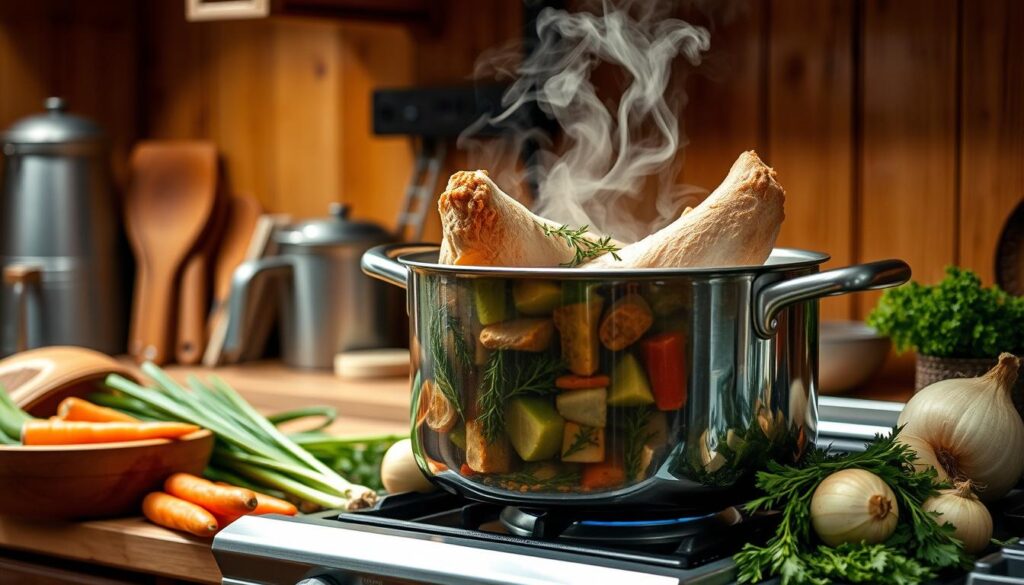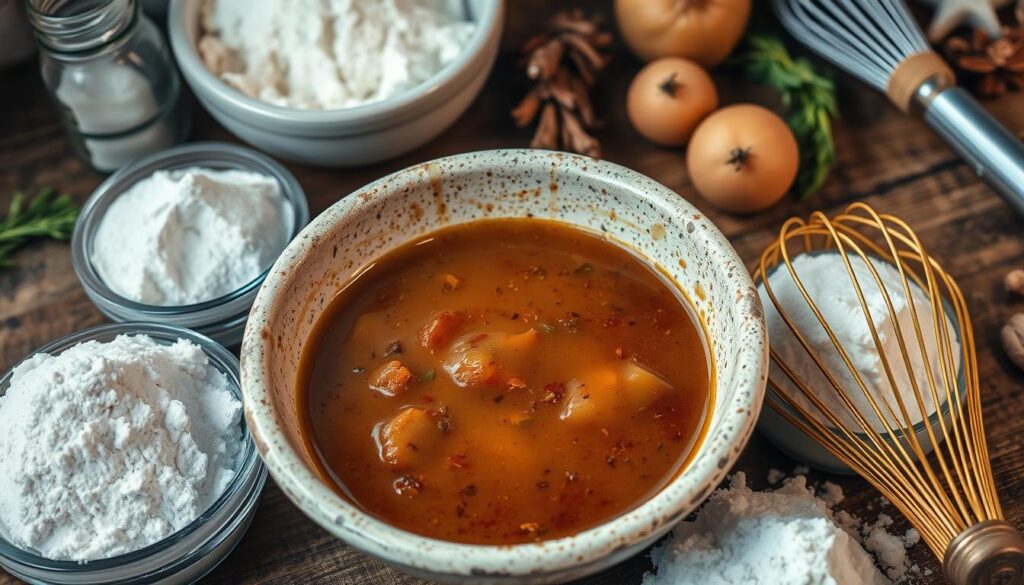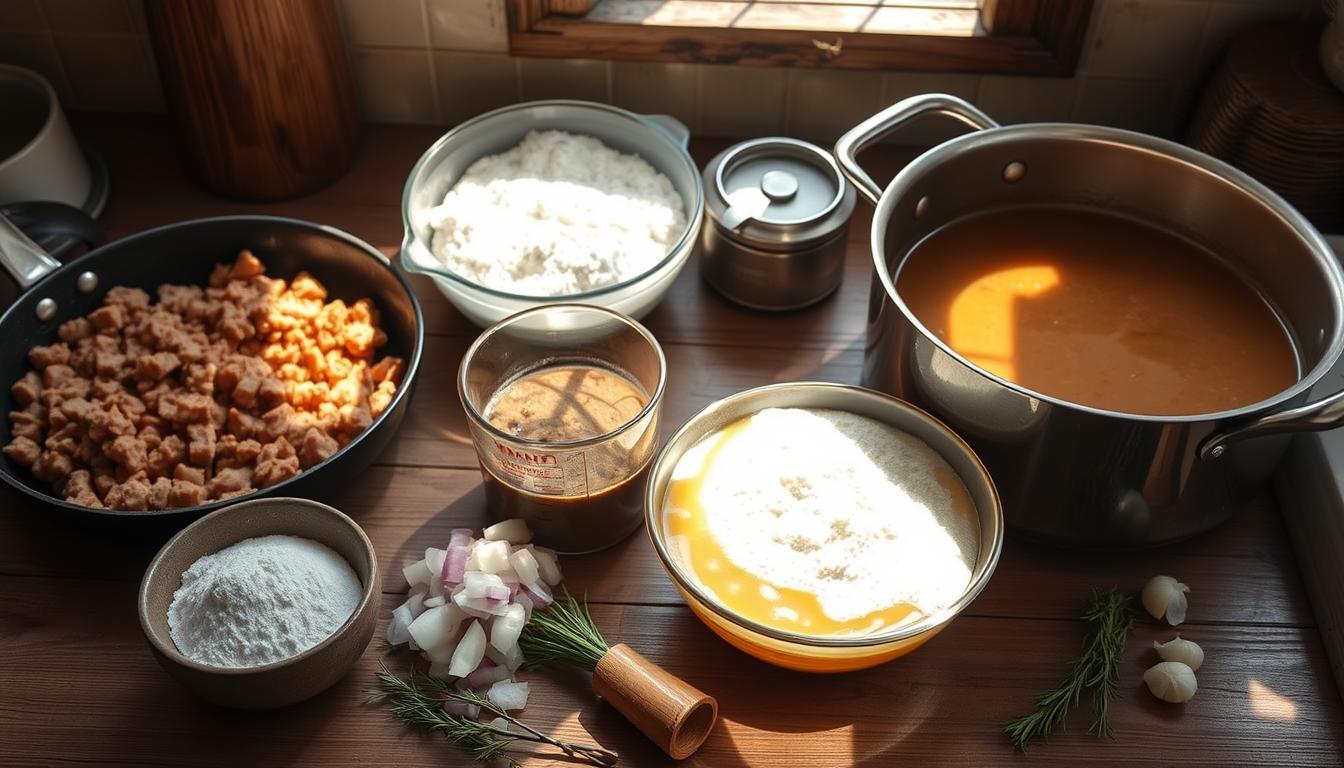Elevate your Thanksgiving dinner with a rich and flavorful sausage turkey fat gravy that will transform your holiday meal. This culinary masterpiece combines ground turkey sausage’s deep, savory notes with traditional gravy techniques to create a luxurious and comforting sauce.
Creating the perfect sausage turkey fat gravy isn’t just about mixing ingredients – it’s an art form that requires precision, technique, and a passion for exceptional flflavorhether you’re a seasoned home cook or a kitchen novice, this guide will walk you through crafting a gravy that will become the star of your Thanksgiving dinner table.
Table of Contents
Understanding Sausage Turkey Fat Gravy
Poultry gravy is more than just a sauce—it’s a culinary tradition that transforms ordinary meals into memorable experiences. Sausage turkey fat gravy brings a unique depth of flavor that elevates cooking to new heights.
What is Sausage Turkey Fat Gravy?
Sausage turkey fat gravy is a rich, flavorful sauce that combines the robust taste of sausage with the luxurious texture of rendered turkey drippings. Unlike traditional gravies, this version offers a complex flavor that tantalizes your taste buds.
- Combines crumbled sausage with smooth turkey fat
- Creates a deeply satisfying sauce for multiple dishes
- Provides a unique culinary experience
Why Use Turkey Fat?
Turkey fat brings an unparalleled richness to your gravy that other faty cannot match. The drippings from roasted turkey wings or thighs provide a depth of flavor that transforms an ordinary sauce into something extraordinary.
| Fat Source | Flavor Intensity | Nutritional Impact |
|---|---|---|
| Turkey Fat | High | Lower in saturated fat |
| Butter | Medium | Higher in saturated fat |
| Olive Oil | Low | Heart-healthy option |
*”A great gravy tells a story of tradition, flavor, and culinary passion.”*
By choosing turkey fat, you’re not just making a sauce—c but after a culinary experience thconnectingenerations of home cook his gravy’s versatility allows you to serve it with biscuits, eggs, mashed potatoes, or virtually any dish that craves a rich, meaty enhancement.
Ingredients You Need to Make Gravy
Creating the perfect sausage turkey fat gravy starts with selecting the right ingredient ouOurravy’s success depends on choosing high-quality components that work together to create a rich, flavorful sauce.
Fresh Sausage Variations
When it comes to sausage, you have several delicious options. Orkk sausage brings a robust flair, while the ground turkey is a cleaner alternative. A type of sausage contributes unique characteristics to your gravy:
- Pork sausage: Rich and traditional
- Ground turkey: Lighter and healthier option
- Spicy breakfast sausage: Adds an extra kick
- Italian-style sausage: Introduces herbal notes
Selecting the Right Turkey Fat
Turkey fat plays a crucial role in developing the depth of flavor. Approximately three tablespoons of turkey fat can transform your gravy from ordinary to extraordinary When selecting your fat source, be mindful of its saturated fat content.
Essential Seasonings
Your gravy’s flavor profile depends on carefully chosen seasoning consider these key ingredients:
- Salt and black pepper
- Garlic powder
- Dried thyme
- Fresh herbs like parsley
“The secret to great gravy is balancing your ingredients and tasting as you go.”
Pro tip: Experiment with different sausage and seasoning combinations to create a gravy that’s uniquely yours. Remember, the right ingredients make all the difference in crafting a memorable sauce.
Preparing the Sausage
Creating the perfect sausage for your gravy starts with careful preparation. Breakfast links are versatile and can transform your gravy from ordinary to extraordinary. Understanding cholesterol is crucial for managing dietary cholesterol and achieving the best flavor.
Cooking Saus when working with sausage to Perfection
The key to exceptional gravy is properly cooked sausage. Follow these steps for the best results:
- Select high-quality breakfast links
- Use a heavy-bottomed skillet for even heating
- Cook on medium-high heat
- Break sausage into small, uniform pieces
- Cook for 5-8 minutes until no longer pink
Managing Excess Fat
Controlling fat is essential for managing dietary cholesterol and gravy consistency. Here’s how to drain excess fat effectively:
- Remove cooked sausage from the pan
- Place sausage on a paper towel-lined plate
- Gently pat to remove additional grease
- Reserve a small amount of fat for flavor
“The secret to great gravy is balancing flavor and nutrition.” – Culinary Expert
Nutritional Considerations
| Nutrient | Amount per Serving |
|---|---|
| Cholesterol | 15mg (5% Daily Value) |
| Total Fat | 3.5g (4% Daily Value) |
| Protein | 7g (5% Daily Value) |
Pro tip: Choose lean breakfast links to reduce dietary cholesterol further while maintaining a rich flavor
Incorporating Turkey Fat
Transforming your gravy from good to extraordinary begins with understanding how to use turkey drippings effectively fat adds rich flavor and depth to your sauce, creating a memorable culinary experience.
Rendering turkey fat requires careful attention to detail When roasting turkey wings or thighs, you’ll collect precious drippings that become the foundation of an exceptional grav ypTypicallycherecommendnds skimming about 2 tablespoons of turkey fat from the pan drippings to create a flavorful base.
Understanding Fat Extraction
The process of extracting fat involves several key steps:
- Let roasted turkey rest for 15-20 minutes
- Carefully tilt the pan to collect drippings
- Use a fat separator or spoon to remove excess saturated fat
- Strain drippings to remove any solid particles
Balancing Fat Usage
While turkey fat adds incredible flavor it’s crucial to be mindful of saturated fat content. Here’s a guide to help you balance taste and nutrition:
| Gravy Type | Fat Amount | Flavor Intensity |
|---|---|---|
| Light Gravy | 1 tablespoon fat | Mild |
| Medium Gravy | 1.5 tablespoons fat | Balanced |
| Rich Gravy | 2 tablespoons fat | Intense |
“The secret to great gravy lies in understanding how to harness the power of turkey drippings.” – Professional Chef
Pro tip: You can store excess turkey fat in an airtight container in the refrigerator for up to a month This allows us to enhance future recipes with its rich, concentrated flavor
The Roux: A Gravy Essential
Creating the perfect sausage turkey fat gravy starts with mastering the roux, a fundamental technique that transforms basic ingredients into a rich, luxurious sauce. The roux serves as the critical foundation for your gravy, providing both thickness and depth of flavor.
Understanding the Roux Basics
A roux is a simple mixture of fat and flour cooked together to create a smooth thickening agent for your sausage turkey fat grav heHeey is to balance the ingredients precisely. Culinaryy experts recommend a specific ratio:
- 1.5 tablespoons of fat (turkey fat or butter)
- 1.5 tablespoons of flour per 1 cup of liquid
- Adjust to 2 tablespoons each for a thicker consistency
Crafting the Perfect Roux
Your roux-making technique can make or breathe grave. Tart by melting your turkey fat or butter in a heavy-bottomed pan over medium heat. Gradually whisk in the flour, creating a smooth pat. His cooking time is crucial:
- Whisk flour into fat for at least 5 minutes
- Cook until the mixture turns a light golden color
- Avoid burning by maintaining ann ing a steady heat
“The secret to a perfect gravy lies in patience and technique during roux preparation.”
Professional chefs recommend cooking the roux for 20-25 minutes, ensuring you remove the raw flour taste while developing a rich, nutty flavor or a sausage turkey fat gravy that truly impresses, take your time and pay attention to the details of your roux.
Adding Liquid: Broths and Stocks
Creating the perfect giblet gravy requires selecting the right liquid. Understanding how broths and stocks can elevate your culinary creativity is the foundation of a remarkable gravy.

The liquid component of giblet gravy plays a crucial role in developing rich, compleflavorr. EExperiencedhome cooks know that homemade stock can transform an ordinary gravy into an extraordinary sauce.
Choosing the Best Broth
Your broth selection can make or break the grave. coConsiderhese options for the most flavorful result:
- Homemade turkey stock (recommended for maximuflavourror)
- Low-sodium chicken broth as an alternative
- Vegetable stock for a lighter base
“The secret to exceptional gravy is a deeply flavored stock” – Professional Chef Recommendation
Adding Flavor with Wine
Enhance your giblet gravy by incorporating a splash of wi. The right wine can add depth and complexity to your sauce e. Considerr these wine options:
- Dry white wine for a subtle brightness
- Sh, err for a nutty undertone
- Marsala for rich,flavoflavoururr
Pro tip: When making homemade stock, simmer turkey wings, vegetables, and herbs for 1-2 hours. tThisprocess extracts flavored flavor create a robust base for your giblet gravy that will impress even the most discerning palates.
Seasoning Your Gravy
Creating the perfect poultry gravy is an art of flflavorlavoursurs, and carefully selected seasonings. The right combination of herbs and spices can transform an ordinary gravy into a memorable culinary experience.
Balancing Flavors in Poultry Gravy
Seasoning poultry gravy requires a delicate touch. Tart with basic seasonings that complement sausage and turkey flavorsaimim to create a harmonious blend that enhances, not overwhelms, the natural taste.
- Salt: Use sparingly, considering the saltiness of the sausage
- Black pepper: Adds warmth and depth
- Garlic powder: Provides a subtle background flavor
Popular Herbs and Spices for Rich Flavor
Elevate your poultry gravy with these classic and adventurous herb combinations:
- Sage: Traditional Thanksgiving herb that pairs perfectly with turkey
- Thyme: Adds earthy undertones
- Rosemary: Brings a pine-like aromatic quality
- Marjoram: Provides a delicate, sweet herb note
“The secret to great gravy is layering flavors with precision and care.”
When seasoning, remember to taste and adjust throughout the cooking process. Start with small amounts and build complexity gradually. A pinch of each herb can make a significant difference in your final poultry gravy.
Thickening Techniques for Gravy
Creating the perfect sausage turkey fat gravy requires mastering the art of thickening. The tight technique can transform your gravy from runny to rich and velvety, elevating your entire dish.

Cornstarch vs. Flour: A Thickening Showdown
When thickening your sausage turkey fat gravy, you have two primary options: cornstarch and flour. Ach has unique properties that enhance your culinary creation.
- Cornstarch provides a glossy, translucent finish.
- Flour offers a more traditional, opaque texture
- Cornstarch requires less quantity for thickening
Thickening Ratios and Tips
Understanding the right proportions is crucial for smooth gravyHerere are some expert guidelines:
- Cornstarch: 1 tablespoon per 1 cup of liquid
- Flour: 2 tablespoons per 1 cup of liquid
- Always mix thickeners with cold water to create a smooth slurry
“The secret to perfect gravy is patience and precision in thickening.” – Culinary Expert
Pro tip: When using cornstarch for your sausage turkey fat gravy, create a slurry by mixing 1 tablespoon of cornstarch with 1-2 tablespoons of cold water. Gradually whisk this into your hot gravy, stirring constantly to prevent lumps.
Achieving Smooth Gravy Every Time
To ensure a silky-smooth texture, follow these techniques:
- Sift flour or cornstarch before mixing
- Use a whisk to incorporate thickeners
- Add thickening agents slowly
- Simmer for 1-2 minutes after adding thickener
Remember, practice makes perfect when creating the ideal sausage turkey fat gravy!
Adjusting Consistency
Perfecting your poultry gravy requires careful attention to its consistencSimplelee techniques can help you achieve the ideal texture, elevating your dish, whether your gravy is too thick or too thin.
Making Your Gravy Thicker
When your poultry gravy seems too thin, you have several options to thicken it up:
- Create a beurre manié by mixing equal parts flour and butter
- Use cornstarch slurry with 2 tablespoons of cornstarch mixed in 1/2 cup of cold liquid
- Simmer the gravy to reduce and concentrate the thflavorsrs
“The secret to perfect gravy is patience and gradual adjustments.”
Lightening Up Your Gravy
If your poultry gravy becomes too thick, you can easily thin it out:
- Gradually whisk in warm stock or water
- Add a little milk for a creamier texture
- Start with small amounts to avoid over-thinning
Remember that gravy thickens as it cools. A good rule of thumb is to aim for a consistency that coats the back of a spoon without sticking like glue.
| Gravy Consistency Issue | Solution |
|---|---|
| Too Thin | Use flour or cornstarch slurry |
| Too Thick | Gradually add warm stock |
| Lumpy | Whisk vigorously or strain |
Always taste and adjust seasonings after modifying your gravy’s consistency to ensure maximum flavor.
Serving Suggestions for Sausage Turkey Fat Gravy
Your Thanksgiving dinner deserves an extraordinary gravy that elevates every bite. Sausage turkey fat gravy isn’t just a condiment—it’s a flavor amplifier that transforms traditional dishes into culinary masterpieces.
Pairing with Traditional Dishes
During Thanksgiving dinner, your gravy can shine across multiple classic recipes. Consider these delectable pairings:
- Roasted turkey slices
- Fluffy mashed potatoes
- Crispy stuffing
- Buttermilk biscuits
- Chicken fried steak
Creative Uses for Leftover Gravy
Your sausage turkey fat gravy offers versatile potential beyond the Thanksgiving dinner table. Imagine your leftovers with these inventive suggestions:
- Breakfast bowl base with eggs and potatoes
- Savouryry sandwich spread
- Casserole topping
- Meat dipping sauce
| Serving Suggestion | Preparation Time | Flavor Profile |
|---|---|---|
| Breakfast Bowl | 10 minutes | Rich, Hearty |
| Sandwich Spread | 5 minutes | Creamy, Robust |
| Casserole Topping | 15 minutes | Comforting, Warm |
Pro tip: Always store leftover gravy in an airtight container. Refrigerate for up to 3 days or freeze for two months to maintain optimal flavor and texture.
“Great gravy turns good meals into memorable experiences.” – Culinary Wisdom
Storing and Reheating Gravy
Preserving the rich flavor of your sausage turkey fat gravy requires careful storage and reheating techniques. heHenroperly handled, gravy can remain delicious for several days or even months. Tore your gravy in an airtight container and refrigerate it within two hours of cooking to maintain its quality and food safety.
Best Practices for Storing
Your sausage turkey fat gravy can be refrigerated in a sealed container in a sealed container for 3-4 days. r longer preservation, freezing is an excellent option. Through dairy ingredients, you can freeze the gravy for up to 4-6 months. Ways use freezer-safe containers and leave some space at the top to allow for expansion during freezing.
How to Reheat Without Compromise
Reheating sausage turkey fat gravy requires attention to prevent burning or separating. r food safety, aim to reheat it to an internal temperature of 165°F. e stovetop method works best: use medium-low heat and whisk occasionally. Using a microwave, heat in 30-second intervals, stirring between bursts. The gravy appears too thick, add a splash of chicken stock to help restore its creamy consistency.
Pro tip: Thaw frozen gravy overnight in the refrigerator before reheatingGradualal thawing helps maintain the gravy’s texture and prevents potential bacterial growth.
FAQ
What exactly is sausage turkey fat gravy?
Can I use different types of sausage in this gravy?
How do I properly render turkey fat for the gravy?
Is sausage turkey fat gravy high in cholesterol?
What’s the secret to a smooth gravy?
How long can I store leftover sausage turkey fat gravy?
Can I use this gravy for more than just Thanksgiving dinner?
What’s the best way to reheat gravy without separating?
Your Thoughts on This Recipe?
There are no reviews yet. Be the first one to write one.

